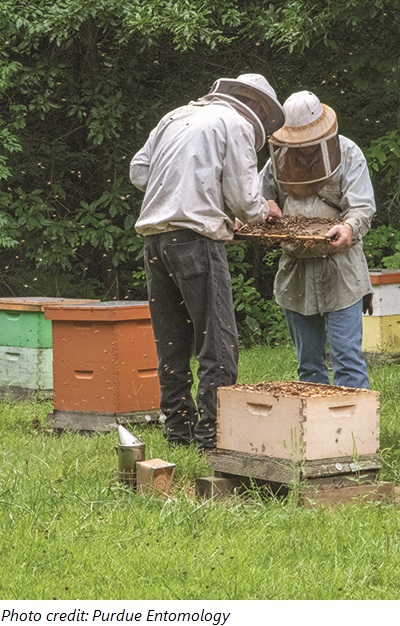On this page:
Triggers for Enhanced Surveillance | Emergency Aerial Pesticide Application | Public Information | Information for Beekeepers | Information for Organic Farmers
Eastern equine encephalitis (EEE) virus is the most dangerous mosquito-borne virus that is naturally present in the state of Indiana. EEE virus outbreaks tend to be cyclical, with an outbreak cycle typically lasting from 1 year to 3 years. When present, EEE virus activity is typically detected beginning in mid-to late August..
Information regarding historical outbreak response activities:
There has been no evidence of EEE virus activity detected so far in 2024. For maps showing recent infections of other arboviral diseases in people, horses, and mosquitoes, click here.
Triggers for enhanced EEE virus surveillance
If any of the following are true within a given year, enhanced surveillance for EEE virus in people, horses, and mosquitoes will be initiated, and the public will be notified via a news release:
- Two equine EEE virus disease cases within 10 miles of one another (whether in the same county or across state or county borders); or
- One or more EEE virus positive mosquito pools in any county or within 5 miles of the state border; or
- One of more human EEE virus disease cases in any county or within 5 miles of the state border.
If ANY additional EEE virus activity is detected beyond these thresholds in the same area, the Indiana Department of Health (IDOH) and local health departments will consider emergency aerial pesticide application as a control measure.
Emergency aerial pesticide application
The method of choice for emergency control of EEE virus is aerial (i.e., by airplane) application of pesticide. The goal of emergency aerial pesticide application is an immediate reduction in risk due to elimination of potentially infected mosquitoes. Other mosquito control methods, such as standing water treatments or truck-mounted pesticide application, are not suitable for control of EEE virus vector mosquitoes, which have a broad flight range (up to 5 miles) and which breed in large, diffuse bodies of freshwater, such as cattail marshes.
IDOH takes the decision to recommend emergency aerial application of pesticide very seriously. This control measure will only be considered when there is evidence of increased risk for this severe disease. IDOH will not initiate aerial pesticide application in any jurisdiction without the explicit invitation and consent of county commissioners and Tribal representatives in affected areas. The public will be notified of emergency aerial pesticide application a minimum of 48 hours in advance.
IDOH uses the pesticide naled (Dibrom concentrate) for emergency control of EEE virus. Naled has been registered by the U.S. Environmental Protection Agency (EPA) for use in the United States since 1959. When used for emergency EEE virus control, an ultra-low volume dose of naled is used (approximately 1 ounce per football field). Naled begins to break down immediately upon release and is not expected to persist in water or soil after application. While alternative chemicals are available, they have not been demonstrated to be as effective as naled at eliminating adult mosquitoes.
Information for the public
When applied by a licensed vector control professional who follows label instructions, aerial pesticide application poses minimal risk to people, pets, animals, and the environment. While it is not necessary to leave an area during aerial pesticide application, people who wish to minimize exposure may choose to stay indoors for several hours, beginning at dusk on the treatment date. People may also choose to bring animals indoors and cover their ornamental fishponds prior to the application. More information about aerial pesticide application may be found here.
Information for beekeepers
Because emergency aerial application of pesticide occurs around sunset, it is not expected to have a major impact on bees, which typically discontinue foraging and return to their hives well before sunset. However, IDOH will conduct outreach to beekeepers in advance of emergency aerial pesticide application as a courtesy. Beekeepers are strongly encouraged to register with Beecheck to aid in notification of pesticide application for public health emergencies. Beekeepers registered with Beecheck will be notified of emergency aerial pesticide application a minimum of 48 hours in advance.
The Purdue University Entomology program has published information about protecting honeybees from area-wide insecticide applications. Beekeepers are encouraged to review this information and develop a plan for implementing this guidance to protect their honeybees during a public health emergency.
Information for organic farmers
Farms that were certified by the United States Department of Agriculture (USDA) National Organic Program and registered in Driftwatch were excluded from emergency aerial pesticide application areas in 2019 and 2020. USDA-certified organic farms are strongly encouraged to register with Driftwatch if they wish to be considered for exclusion from future emergency aerial pesticide applications. However, IDOH cannot guarantee exclusion of USDA-certified organic farms from application areas if the effectiveness of the application would be negatively affected.
IDOH will conduct outreach to USDA National Organic Program farm certifiers in advance of emergency aerial pesticide application to encourage them to help their farms register with Driftwatch. USDA-certified organic farms registered with Driftwatch will be notified of emergency aerial pesticide application a minimum of 48 hours in advance. IDOH will also notify the USDA National Organic Program following an emergency aerial pesticide application.
For additional information, please contact the IDOH Epidemiology Resource Center at 317-233-7125.
Return to the EEE virus page here.
Page Last Updated August 30, 2024
